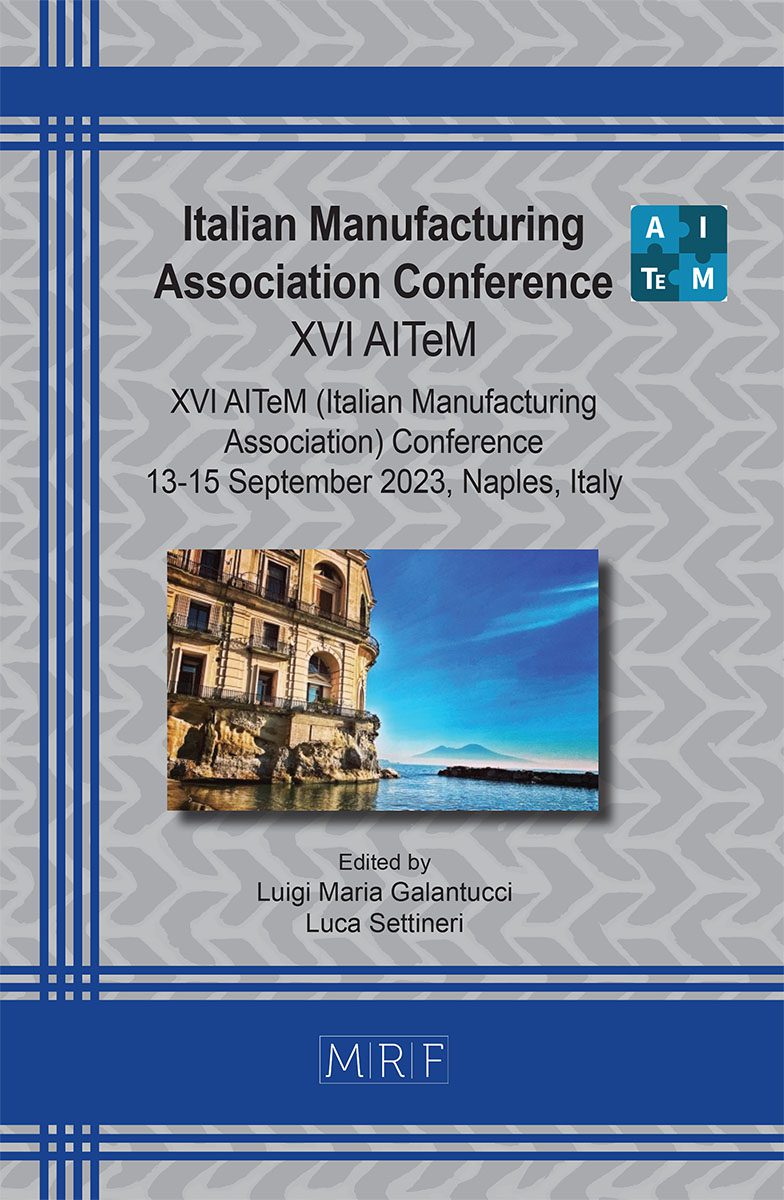Influence of long and short glass fiber on the mechanical behaviour of a single cell metamaterial
Luca Giorleo, Antonio Fiorentino, Stefano Pandini, Elisabetta Ceretti
download PDFAbstract. Additive manufacturing is presenting new challenges in various aspects of part production. Among these, the potential benefits derived from material complexity have been growing in recent years, especially when using polymeric materials. In fact, mixing polymers with long/short fibres lead to moderate to significant improvements in the mechanical properties of the parts. The degree of improvement strongly depends on the part geometry and can become critical in the case of a workpiece with a repeating pattern, such as metamaterials. In this preliminary research, the authors investigate the mechanical performance of a single- hourglass cell which is a common auxetic geometry used to achieve a negative Poisson ratio in metamaterials. Nylon was used as the matrix, and glass as the fibre. FFF additive process was used to produce samples with different cell designs (in width, size, inclination) and the nature of the fibres (long and short). The results were analysed using statistical methods.
Keywords
Material Extrusion, FFF, Fibre Reinforced Plastic, Metamaterial, Tensile Strength, Poisson Ratio
Published online 9/5/2023, 4 pages
Copyright © 2023 by the author(s)
Published under license by Materials Research Forum LLC., Millersville PA, USA
Citation: Luca Giorleo, Antonio Fiorentino, Stefano Pandini, Elisabetta Ceretti, Influence of long and short glass fiber on the mechanical behaviour of a single cell metamaterial, Materials Research Proceedings, Vol. 35, pp 495-498, 2023
DOI: https://doi.org/10.21741/9781644902714-58
The article was published as article 58 of the book Italian Manufacturing Association Conference
![]() Content from this work may be used under the terms of the Creative Commons Attribution 3.0 license. Any further distribution of this work must maintain attribution to the author(s) and the title of the work, journal citation and DOI.
Content from this work may be used under the terms of the Creative Commons Attribution 3.0 license. Any further distribution of this work must maintain attribution to the author(s) and the title of the work, journal citation and DOI.
References
[1] Essassi K., Rebiere J.-L., mahi A.E., Souf M.A.B., Bouguecha A., Haddar M., Indentation Characteristics of Auxetic Composite Material (2023) Lecture Notes in Mechanical Engineering, pp. 520 – 526. https://doi.org/10.1007/978-3-031-14615-2_58
[2] Li Z.-Y., Wang X.-T., Ma L., Wu L.-Z., Wang L., Auxetic and failure characteristics of composite stacked origami cellular materials under compression (2023) Thin-Walled Structures, 184, art. no. 110453. https://doi.org/10.1016/j.tws.2022.110453
[3] Carneiro V.H., Meireles J., Puga H., Auxetic materials – A review (2013) Materials Science- Poland, 31 (4), pp. 561 – 571. https://doi.org/10.2478/s13536-013-0140-6
[4] Yang W., Li Z.-M., Shi W., Xie B.-H., Yang M.-B., On auxetic materials (2004) Journal of Materials Science, 39 (10), pp. 3269 – 3279. https://doi.org/10.1023/B:JMSC.0000026928.93231.e0
[5] Duncan O., Shepherd T., Moroney C., Foster L., Venkatraman P.D., Winwood K., Allen T., Alderson A., Review of auxetic materials for sports applications: Expanding options in comfort and protection (2018) Applied Sciences (Switzerland), 8 (6), art. no. 941. https://doi.org/10.3390/app8060941
[6] Chen, Y., He, Q. 3D-printed short carbon fibre reinforced perforated structures with negative Poisson’s ratios: Mechanisms and design (2020) Composite Structures, 236, art. no. 111859. https://doi.org/10.1016/j.compstruct.2020.111859
[7] Ingrole, A., Hao, A., Liang, R. Design, and modeling of auxetic and hybrid honeycomb structures for in-plane property enhancement (2017) Materials and Design, 117, pp. 72-83. https://doi.org/10.1016/j.matdes.2016.12.067
[8] Quan, C., Han, B., Hou, Z., Zhang, Q., Tian, X., Lu, T.J. 3d printed continuous fiber reinforced composite auxetic honeycomb structures (2020) Composites Part B: Engineering, 187, art. no. 107858. https://doi.org/10.1016/j.compositesb.2020.107858
[9] Najafi, M., Ahmadi, H., Liaghat, G. Experimental investigation on energy absorption of auxetic structures (2019) Materials Today: Proceedings, 34, pp. 350-355. https://doi.org/10.1016/j.matpr.2020.06.075
[10] Lvov, V.A., Senatov, F.S., Korsunsky, A.M., Salimon, A.I. Design and mechanical properties of 3D-printed auxetic honeycomb structure (2020) Materials Today Communications, 24, art. no. 101173. v10.1016/j.mtcomm.2020.101173
[11] Pappas J.M., Thakur A.R., Leu M.C., Dong X. A comparative study of pellet-based extrusion deposition of short, long, and continuous carbon fiber-reinforced polymer composites for large-scale additive manufacturing (2021) Journal of Manufacturing Science and Engineering, Transactions of the ASME, 143 (7), art. no. 071012. https://doi.org/10.1115/1.4049646












